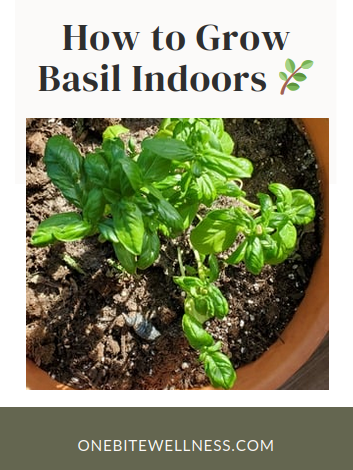Looking to add a burst of fresh flavor to your meals while also enhancing your indoor space?
Growing basil is a rewarding and surprisingly simple way to do both! As a registered dietitian-nutritionist, I often recommend herbs like basil for their nutritional benefits as well as culinary versatility. Let’s explore the basics of growing this aromatic herb right in your own home.
Can I actually grow this?
Yes! We previously had what some would say were ‘black thumbs’ and were only reliably able to keep our aloe plant alive (which we did for decades, throughout college and through many moves). Here’s our general recommendation for growing plants – start small. Maybe begin with basil, which we’re covering here, and then try rosemary or thyme. Add to your knowledge, don’t do it all at once!
Why Choose Organic Basil?
Organic basil offers numerous health benefits. It is rich in vitamins A, K, and C, as well as minerals like manganese, which supports healthy bones. Choosing organic ensures that your basil is grown without synthetic pesticides or herbicides, promoting both your health and the environment’s well-being.
Disclosure: some of the links below are affiliate links or discount codes, meaning, at no additional cost to you, if you click through an affiliate link and make a purchase, we may make a commission.
A Guide to Getting Started
To start your indoor basil garden, you’ll need a few key items:
Basil loves sunlight, so choose a sunny windowsill or a spot where it can receive at least 6-8 hours of sunlight daily.
Select a pot with drainage holes to prevent over-watering. A 6-8 inch diameter pot should be sufficient for one basil plant.
Use a well-draining, organic potting mix to ensure proper root growth and prevent waterlogged soil.
You can start with basil seeds or purchase seedlings from a nursery or garden center for quicker results.
Planting Your Basil
Fill your pot with organic soil, leaving about an inch of space below the rim. If using seeds, sprinkle them evenly over the soil and cover lightly with a thin layer of soil. If using seedlings, gently remove them from their nursery container and plant them in the center of your pot.
Water your basil plant regularly (at least once per week), keeping the soil moist but not waterlogged. Allow the top inch of soil to dry out between waterings (use your finger to estimate and don’t let it dry out further than that inch or you may lose the plant).
Place your pot in a sunny spot where it can receive plenty of sunlight each day (we use the south side window). Pro tip: rotate the pot occasionally to ensure even growth.
Caring for Your Basil
Regularly pinch off the top leaves of your basil plant to encourage bushier growth. This also prevents the plant from flowering too soon, which can affect the flavor. If a flower bud appears, snip it off just above the pair of opposing leaves beneath the bud. You (and your bunnies) can eat those tasty basil buds!
If you want to be a truly awesome plant parent, use a balanced organic fertilizer once a month to provide your basil with essential nutrients for healthy growth. Sometimes we do great parenting and sometimes we just throw some occasional coffee grounds or stale beer on it (these are also natural fertilizers, by the way).
You can start harvesting basil leaves once the plant has grown to a reasonable size of about 6-8 inches tall. Use those sharp scissors to snip off the top leaves and leave at least a few sets of leaves on the plant to continue growing.
Now for the Most Fun Part – Eating Your Homegrown Basil!
Fresh basil adds a delightful flavor to a variety of dishes, including Caprese salads, pasta, soups, pizza, and sauces. You can also use it to make pesto, a versatile sauce that can be used in pasta dishes, as a spread on sandwiches or substituted for marinara sauce on pizza!
With these simple steps, you can enjoy a bountiful harvest of organic basil right from your own home. Not only will you enhance your culinary creations, but you’ll also reap the nutritional benefits of this versatile herb and save money (and the environment) on those grocery herbs in little plastic containers. You can do this! Happy growing!
